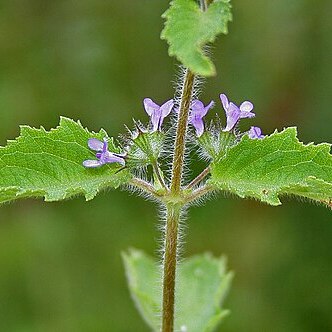A strongly aromatic, almost fetid, much-branched herb, 0.5-2 m high. Stem hirsute, 4-angled. Leaves firmly herbaceous, ovate to broadly obovate, 3-5 by 2-4 cm, subacute, base rounded, truncate, often slightly oblique; margin irregularly serrulate; sparsely pilose above, densely pubescent beneath; petiole slender, 0.5-3 cm, sparsely pubescent. Flowers in lax, 2-5-flowered secund cymes, arranged racemosely towards the ends of branches in the axils of smaller leaves. Peduncles pubescent, 0.5-1 cm long. Bracts minute, setaceous. Calyx campanulate, 5-5.5 mm long, in fruit 8-10 mm, strongly ribbed; mouth villous; teeth erect, setaceous. Corolla blue or bluish violet; tube slender. Anthers purple. Nutlets narrowly oblong, 1.2-1.5 mm long, often emarginate at the top, faintly rugose, dark brown; pericarp swelling to a gelatinous mass when soaked in water.
Herbs annual, aromatic, robust, branched, erect. Stems 0.6-1.6 m, spreading hispid. Petiole slender, 0.5-6 cm; leaf blade ovate to broadly ovate, 1.4-11 × 1.2-9 cm, adaxially olive green, abaxially pilose, base rounded to shallow cordate, oblique, margin serrulate, apex subacute to obtuse. Cymes (1-or) 2-5-flowered, in racemes or panicles. Calyx ca. 5 × 3 mm, dilated to 12 × 6.5 mm in fruit, villous, yellowish glandular, throat tufted villous, veins very elevated; teeth broadly triangular, long subulate, 1.5-2 mm. Corolla blue, 6-8 mm, puberulent except near base; tube ca. 2 mm wide at throat; upper lip lobes reflexed; middle lobe of lower lip shorter, lateral lobes similar to upper lip. Nutlets dark brown, 2, flattened, ca. 4 × 3 mm, dotted, with 2 basal white scars. Fl. and fr. year round.
A herb which keeps growing from year to year. It grows 70 cm high. It can grow as an annual and can be 3 m high. The stems are rounded in the lower sections and 4-angled higher up. They are hollow. They are hairy. The leaves are produced opposite each other. They have teeth around the edge. They have a strong minty smell when crushed. The leaves are 3-10 cm long by 2-7 cm wide. They have a wavy edge and are rough underneath. The flowers are produced in small clusters in the axils of leaves. The flowers are blue. The fruit are papery brown capsules. The fruit consists of 2 nutlets. They are 3-4 mm long and flattened. They are dark brown.

